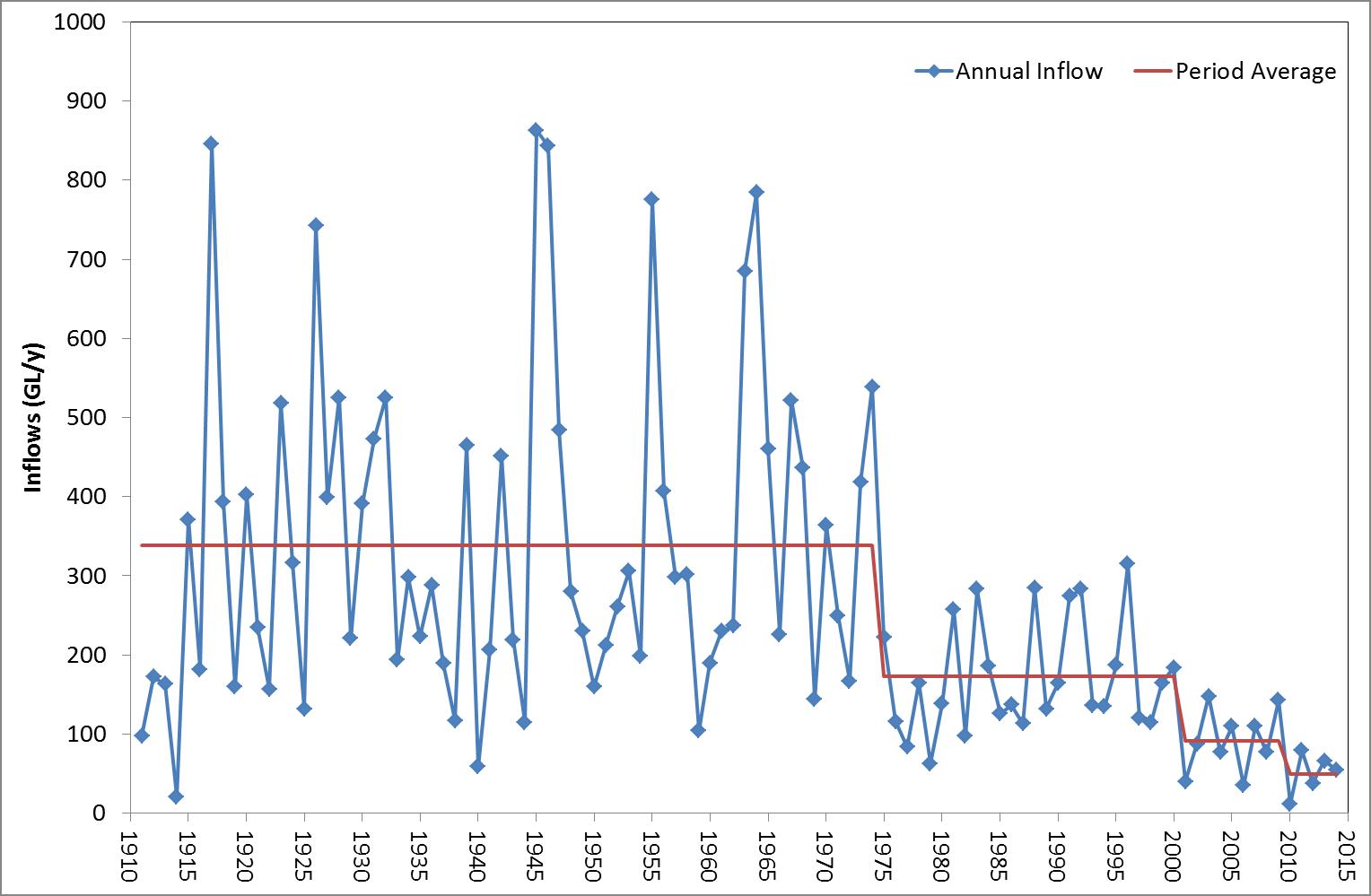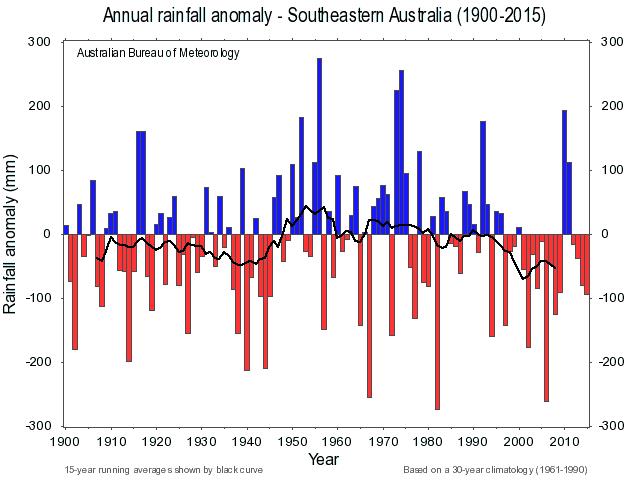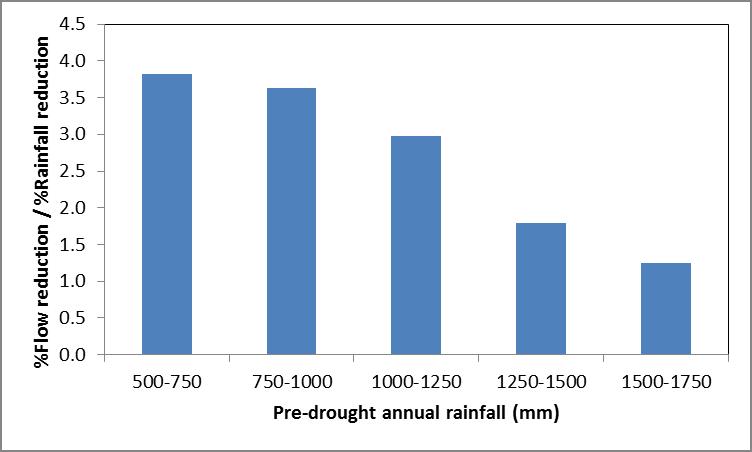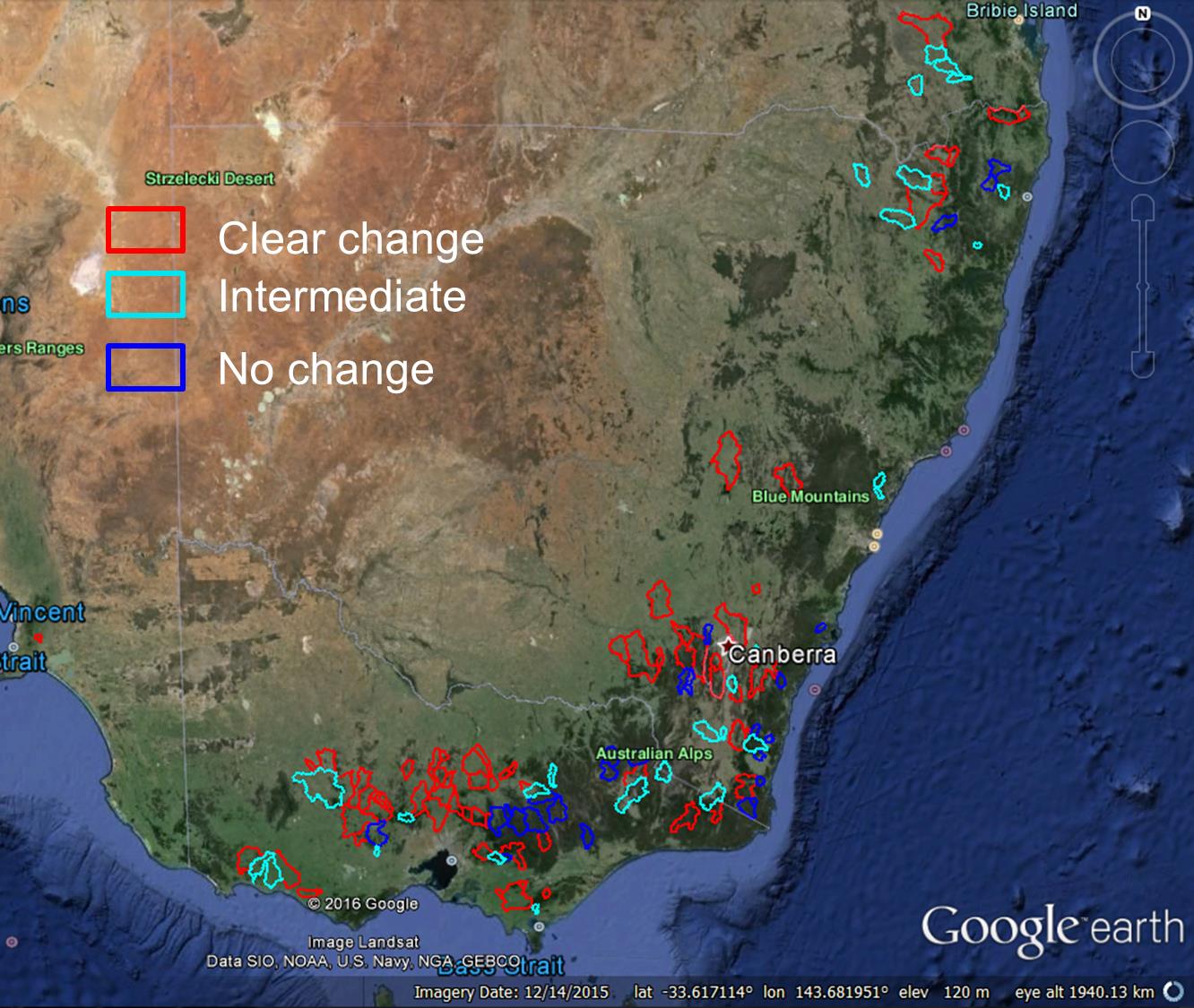The future of irrigation whats in store
Author: Andrew W Western, Margarita Saft and Murray C Peel (Department of Infrastructure Engineering, The University of Melbourne). | Date: 28 Jul 2016
Background
This paper aims to provide some insight into potential future climate impacts on water resources and their interpretation from an irrigator’s perspective. It begins with a real-world case study; Perth’s water supply catchments. We then consider what can be learnt from the impacts of the Millennium Drought on runoff and finish with some comments about climate change and the implications for future water resources. One of the most challenging aspects of climate change projections is the associated uncertainty. Here we will try to provide some insights into uncertainties from a water resources perspective. In doing this we will consider broad spatial variations across systems but it should be noted that water can be transferred across many of the subsystems in the northern Victorian and Murrumbidgee systems and this needs to be considered in any assessments of potential water resource futures.
A cautionary tale
South-west Western Australia provides a cautionary tale of past changes in streamflows (Figure 1). It can be seen that dam inflows have progressively declined since about 1974. These declines are associated with regional changes in rainfall. This example illustrates two issues using a real-world example that has led to serious water resources challenges. First, major and sustained changes in streamflows are possible and have been experienced in Australia. Second, declines in runoff tend to be much greater than declines in rainfalls. Rainfalls in south-west Western Australia have declined by around 20 per cent across the region, while streamflows have declined by around 80 per cent. Perth is now a city that depends very heavily on groundwater and desalination for the city’s water supply.

Figure 1: Changes in inflows to Perth’s water supply reservoirs (excluding Stirling and Samson Brook Dams). Data source Water Corporation website.
How much do southern Murray-Darling Basin flows respond to rainfall changes?
From a local perspective we can learn from the Millennium Drought. The Millennium Drought lasted from around 1997 to 2010, with some variations from place to place. This was an unprecedentedly long period of low rainfall conditions and differed from other extended periods of low rainfall such as the years around 1940 in that the dry conditions were continuous. That is, they were not interrupted by occasional wetter years. Figure 2 illustrates this with nine years in a row of below average rainfall from 2001 to 2009 and of all the years from 1997 to 2009, only 2000 had an annual rainfall that was (only marginally) above average. While rainfall averages during the Millennium Drought were often the lowest on record, there have been individual years in the past with lower rainfall (e.g.1982) and there was a period around 1940 which also had quite low rainfalls but it was interrupted more by above average rainfall years. Given the unusually long period of the Millennium Drought, it provides an unusual opportunity to examine changes in catchment response to quasi-permanent change.
In looking at runoff responses to changing rainfall, there are two aspects we want to touch on here. The first is the question of how much larger is the runoff response than the rainfall response, and the second is, are short and long droughts different in terms of runoff response? We will draw on studies by (Saft, Peel, Western, Perraud & Zhang, 2016; Saft, Western, Zhang, Peel, & Potter, 2015) which consider 124 catchments in which the Millennium Drought led to uninterrupted dry periods of at least seven years. The following summarises results from those papers, and re-expresses some of the results in a more digestible form.

Figure 2: Annual rainfall anomalies for south-eastern Australia. The average rainfall is 640mm/a. Above the line bars show years with higher than average rainfall and below the line bars show years with lower than average rainfall. The black line shows a 15 year moving average. Source BoM website.
Figure 3 shows the percentage reduction in streamflow divided by the percentage reduction in rainfall for the Millennium Drought averaged across catchments in different rainfall zones. It is very clear that as annual rainfall declines, the change in runoff relative to rainfall becomes larger. In the southern Murray Darling Basin this roughly translates into runoff changes being proportionally larger the further west you go in Victoria. The Murrumbidgee is also more sensitive than the mountain catchments in Victoria. It is important to recognise that most of the runoff in the Murray/Murrumbidgee basins is from the high rainfall mountain catchments. Overall the percentage declines in runoff during drought were around 2-2.5 times the rainfall reduction in these catchments. In terms of total runoff from the high rainfall (>1000mm/a) study catchments, drought runoff declined by 25-75 per cent with an average of 45 per cent. It is also clear that those reliant on say the Loddon (around 650mm/a rainfall) are exposed to greater fluctuations in water supply as rainfall varies, with runoff from study catchments in the Loddon basin declining by 70 to >90 per cent during the study period, even though percentage rainfall reductions were similar to other areas.

Figure 3: Changes in streamflow relative to rainfall change for southern Murray-Darling Basin catchments during the Millennium Drought.
The second question is: are long droughts different to short droughts in terms of runoff declines. During the Millennium Drought more than half of the catchments that we analysed had runoff reductions greater than those that occurred during short droughts with similar rainfall reductions. Essentially streamflows were less than expected during the Millennium Drought due to fundamental changes in catchment response. Figure 4 shows where this occurred to a marked extent. Generally drier, flatter and more cleared catchments are more susceptible to larger than expected runoff reductions.
There are several implications of these findings. First they increased the challenge for managing water resources during the drought as this phenomenon had not been seen previously/was not expected and already stressed systems faced with extremely low inflows from 2006 through 2009. The models that are used in managing drought were susceptible to overestimating dam inflows during this period (Saft et al., 2016). Second they have implications for future planning for drought and climate change. This planning often uses models that are prone to over-predicting flows under dry conditions, which can lead to an under-estimation of the risk of inflow reductions. Finally these reductions were observed in more than 50 per cent of catchments and it is possible that the phenomenon could become more widespread if dry conditions persisted for even longer than the Millennium Drought. While the experiences of the Millennium Drought are now built into water resources planning, future droughts and climate shifts will be different and the responses will be different, hence it is important to try to improve our estimates of future runoff responses to provide an improved basis for planning.

Figure 4: Study catchments that showed no change and a very clear reduction in rainfall-runoff response during the Millennium Drought compared with shorter droughts with similar rainfall reductions. Intermediate catchments are also shown and these exhibited a tendency towards reduced runoff but it was not statistically significant (n.b. no change areas tend to be located in ‘high country’ areas). Source Google Earth and Saft et al. (2016).
What about climate change?
Figure 2 shows that average rainfalls have generally been declining over south-eastern Australia since the 1950s. Most climate change projections also suggest that rainfalls will decline over southern Australia, although there is significant uncertainty. From an irrigation perspective, this might mean a greater water requirement due to declining rainfall (and minor increases in evaporative demand) combined with less water resouce, although rainfall changes are unlikely to be seasonally uniform. As we have seen, any decline in rainfall will be significantly amplified in runoff and dam inflows. The extent of this amplification will be greater in systems where the source catchments are drier.
Perhaps the greatest challenge in adapting to climate change is the uncertainty that exists. There are at least three important sources of uncertainty. One is how the climate system itself will respond to emissions. While many of the climate models agree on the direction of precipitation change (this agreement is strongest in the south), there is significant variation in the amount of change. The second is uncertainty in future emissions growth. This is essentially a socio-political question that remains opaque. The third is the response of streamflow to rainfall changes. The work described above has identified this as a greater source of uncertainty than was previously thought and suggests that runoff declines may be under-estimated. However, it is reasonably clear that these uncertainties and the impact of climate change on water availability will be significantly larger in systems that harvest water from drier catchments.
From a climate change perspective it is also important to remember that the most certain future changes are that daytime temperatures will rise and that CO2 concentrations will increase. Both of these have implications for plant production that should be considered and may also present some adaptation opportunities (e.g. changing growing season could enable shifts in crop timing).
Finally it is tempting to compare climate change scenarios to weather variations from day-to-day and year-to-year, which are typically larger (i.e. a 1 degree of warming and a 10% rainfall reduction seem like small changes, but according to the climate analogues explorer (Climate Change in Australia website) it is equivalent to the difference between Melbourne and say Shepparton). For those wanting to find examples of places that might provide an example of potential future climate, that site is very useful.
Conclusion
The key points of this paper are that climate change is likely to lead to reductions in rainfall. These reductions in rainfall will be amplified such that proportional reductions in runoff are likely to be two to four times larger. That is a 10 per cent rainfall reduction will lead to a 20-40 per cent reduction in runoff. The runoff reductions will be larger in drier catchments, making the water supply systems with drier source catchments more vulnerable. The experience of the Millennium Drought has shown that reductions in runoff under persistent climate changes (~10 year drought) are larger than reductions that occur for short droughts with similar rainfall reductions in many catchments.
References
Saft, M., Peel, M. C., Western, A. W., Perraud, J.-M., & Zhang, L. (2016). Bias in streamflow projections due to climate-induced shifts in catchment response. Geophysical Research Letters, 43, 1574–1581. doi:10.1002/2015GL067326
Saft, M., Western, A. W., Zhang, L., Peel, M. C., & Potter, N. J. (2015). The influence of multiyear drought on the annual rainfall‐runoff relationship: An Australian perspective. Water Resources Research, 51, 2444–2463.
Useful resources
Climate Change in Australia website
Contact details
Andrew Western
Department of Infrastructure Engineering
The University of Melbourne
03 8344 7305
a.western@unimelb.edu.au
Was this page helpful?
YOUR FEEDBACK
